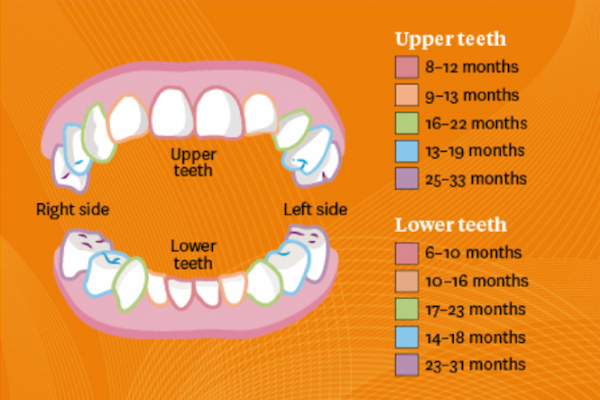Wishing everyone happy holidays and a joyful New Year from the Healthify team. Don't forget to Slip, Slop, Slap and Wrap!
Teething
Key points about teething
- Discomfort associated with teething in infants is common.
- Many babies' teeth come through without any problems other than increased dribbling but for some, teething can make them mildly unwell and irritable.
- Teething doesn't cause serious illness.
- Take your child to the doctor if they have a high temperature, diarrhoea, sore ears, are not drinking or seem to be unwell (rather than just grizzly).

For information and support about teething – talk to your doctor, pharmacist, practice nurse or Plunket nurse. You can also phone Healthline free (within New Zealand) on 0800 611 116 for health advice. Calls are answered by registered nurses or other health professionals.
Most children will get their first tooth between the age of 6 and 10 months, although some children will be earlier and some later. The lower (bottom) front teeth usually come through the gum first. These are followed by the upper (top) front teeth. The picture below shows when each tooth usually appears.

Image credit: Ministry of Health, NZ
The skin over the tooth may become red and swollen, and look tight and shiny. Some children find this painful. For others it is only a minor irritation.
For some children, teething also causes low-grade fever, loss of appetite, dribbling, upset stomach and/or skin rashes. The child may be grizzly and hard to please when awake, and have difficulty sleeping. Teething should not make your child very unwell, so symptoms such as diarrhoea or high fever should not be seen as a normal part of teething.
Giving your baby something cold to suck or chew on can help relieve the pressure and soothe inflamed gums.
- If they have started solids a chilled banana may be soothing, but watch closely because of the risk of choking on small bits.
- Some babies like sucking on a flannel that has been moistened and put in the freezer for a few hours.
- You can also buy solid, silicon-based teething rings that you cool in the fridge (not freezer – too cold) and give to your child to chew on.
- Don't dip them in sweet substances such as honey or syrup as this may lead to dental cavities. Teething biscuits and rusks that contain sugar are not recommended.
Also try gently but firmly massaging or pressing on your baby's gums, using a clean finger or soft cloth. If this obviously upsets your child do not continue.
Teething gels such as Bonjela soothing teething gel® can be bought over the counter at your supermarket or pharmacy. There's little evidence that teething gels are effective in reducing the pain and discomfort associated with teething. This may be because most of the gel is likely to be quickly removed by the tongue and saliva.
Read more about Bonjela soothing teething gel®.
Video: How do I soothe my teething baby?
This video may take a few moments to load.
(NHS, UK, 2015)
Yes, if needed you can give your baby liquid paracetamol to control pain. Weigh your baby and check the dosage information on the package. Give them the correct dose based on their weight and don't exceed 4 doses in 24 hours. Ask your doctor or pharmacist if you're unsure how much to give your baby. Read more about paracetamol for children.
Necklaces made from amber beads have been gaining popularity for use in babies who are teething. It is claimed that the amber soothes the pain of teething when worn next to the skin. These necklaces are not recommended as there is no evidence that amber offers effective pain relief and they pose a serious risk of choking or strangulation.
If you choose to use this device, you must supervise your baby at all times (including sleeping) while wearing the necklace.
To help prevent rashes on the face, use a warm, clean flannel to gently wipe away dribble and then apply a protective ointment like Vaseline or lanolin.
Some children are more susceptible to nappy rash when they are teething. Change dirty nappies regularly, and wash the baby's skin with warm water and mild soap after each bowel motion. Applying a barrier cream or ointment will also help protect baby’s skin.
Teething tots(external link) KidsHealth, NZ, 2018
Teething(external link) Health New Zealand | Te Whatu Ora
References
- Common issues in paediatric oral health(external link) BPAC, NZ, 2010
- Topical oral choline salicylate gels – safety in children(external link) Medsafe Prescriber Update, NZ, 2009
- Choline salicylate(external link) New Zealand Formulary for Children, 2019
Credits: Healthify Editorial Team. Healthify is brought to you by Health Navigator Charitable Trust.
Reviewed by: Lee-Ora Lewis, Clinical Nurse Director, Totara Health
Last reviewed:
Page last updated:





